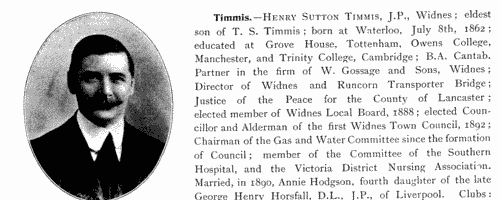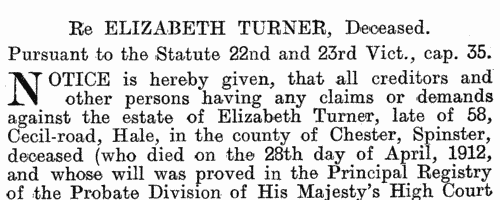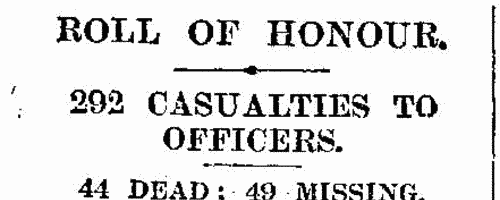Add this eBook to your basket to receive access to all 85 records. Our indexes include entries for the spelling layfield. In the period you have requested, we have the following 85 records (displaying 61 to 70): These sample scans are from the original record. You will get scans of the full pages or articles where the surname you searched for has been found. Your web browser may prevent the sample windows from opening; in this case please change your browser settings to allow pop-up windows from this site. Debtors, Insolvents and Bankrupts
(1887)
Bills of sale (binding assets to a creditor/lender), insolvencies and bankruptcies in England and Wales, April to June 1887 | Sample scan, click to enlarge

| Debtors, Insolvents and Bankrupts
(1887)
Bills of sale (binding assets to a creditor/lender), insolvencies and bankruptcies in England and Wales, July to September 1887 | Sample scan, click to enlarge

| Estates of the Deceased
(1887)
Distribution of the assets of the deceased: giving the names of the deceased and trustees &c. England and Wales | Sample scan, click to enlarge

| Missing Next-of-Kin and Heirs-at-Law
(1900)
The Unclaimed Money Registry and Next-of-Kin Advertisement Office of F. H. Dougal & Co., on the Strand in London, published a comprehensive 'Index to Advertisements for Next of Kin, Heirs at Law, Legatees, &c., &c., who have been Advertised for to Claim Money and Property in Great Britain and all Parts of the World; also Annuitants, Shareholders, Intestates, Testators, Missing Friends, Creditors or their Representatives, Claimants, Unclaimed and Reclaimed Dividends and Stock, Citations, Administrations, Rewards for Certificates, Wills, Advertisements, &c., Claims, Unclaimed Balances, Packages, Addresses, Parish Clerks' Notices, Foreign Intestates, &c., &c.' The original list was compiled about 1880, but from materials dating back even into the 18th century: most of the references belong to 1850 to 1880. For each entry only a name is given, sometimes with a placename added in brackets: there may be a reference number, but there is no key by which the original advertisement may be traced. The enquirer of the time had to remit £1 for a 'Full and Authentic Copy of the Original Advertisement, together with name and date of newspaper in which the same appeared'. This appendix to the list was issued in about 1900. | Sample scan, click to enlarge

|  British artillerymen fighting in South Africa
(1899-1902) British artillerymen fighting in South Africa
(1899-1902)
The Queen Victoria's South Africa Medal was awarded (after her death, in the event) to all who had served honourably in the various campaigns in the Boer War. Returns were made from each unit, and consolidated into nominal roll, of which this is the one for the Royal Artillery. Confusingly, the ledgers used had originally been printed for a register of men transferred (or re-transferred after mobilization) to 1st Class Army Reserve. All the original column headings were therefore struck through, and the roll was prepared with this information: Date of Issue; Regimental Number; Rank; Name; Unit; Medal (a 1 indicating that a medal was awarded); [number of] Clasps; the reference to the source in the original returns, usually starting with AG for papers in the hands of the Adjutant-General, and 68/Art/ for the Royal Artillery records. The final column, normally left blank, was occasionally used for explanatory remarks. | Sample scan, click to enlarge

| Wives of Eminent Lancashire Men of Commerce
(1903)
The Contemporary Biography in 'Lancashire at the Opening of the Twentieth Century' was edited by William Thomas Pike. After opening with the most eminent men in the county, there are twelve sections, dealing with Nobility, Gentry and Magistrates; Clergy; Volunteers; Medical Men; the Legal Profession; Art, Music, Literary and Scholastic; Commercial; Dental; Architects, Engineers and Surveyors; Accountants, Auctioneers, Estate Agents, Insurance, &c.; Veterinary Surgeons; and an Obituary. Each biography usually (but not invariably) has a photograph; full name (surname first, in bold; christian name(s) in capitals) and address; birth place and date; father's name (and sometimes details); a short biography; whether married, with wife's name and her father's name and address. | Sample scan, click to enlarge

|  Queen's South Africa Medal: Royal Field Artillery: 61st Battery
(1901-1905) Queen's South Africa Medal: Royal Field Artillery: 61st Battery
(1901-1905)
The nominal roll for the Queen Victoria's South Africa Medal - awarded (after her death, in the event) to all who had served honourably in the various campaigns in the Boer War - was compiled from these returns from the individual units. Two sets of form were completed. The main one, as in the sample scan, dates from 1901 and gives regimental number, rank, and full name (surname first), followed by a series of columns relating to different actions - Belmont, Modder River, Paardeberg, Dreifontein, Wepener, Johannesburg, Diamond Hill, Belfast, Wittebergen, Defence of Kimberley, Relief of Kimberley, Defence of Mafeking, Relief of Mafeking, Cape Colony, Orange Free State, Transvaal, Rhodesia, Talana, Elandslaagte, Tugela Heights, Defence of Ladysmith, Relief of Ladysmith, Laing's Nek, and Natal; each entitled the man to a separate clasp to the medal, and a tick or a Yes in the appropriate column indicates the man's actual physical presence in that battle. A final column for remarks is important in those cases where the man was no longer in the unit, by removal, death or desertion. The second form that sometimes occurs was returned in 1905, and covers men entitled to the Second South African War Medal and Clasps. It lists men by number, rank and name, checks whether they had claimed the Queen's South Africa Medal, and then enquires as to their suitability as to three Colony Clasps, which could be awarded for service in the Cape, Orange Free, or Transvaal; whether entitled to Date Clasps (South Africa 1901 and South Africa 1902); whether also entitled to the King's South Africa Medal; any other corps in which served in South Africa; and remarks (such as becoming non-effective, forfeiture, &c.) WO 100/142
| Sample scan, click to enlarge

| Estates of the Deceased: County Durham
(1912)
Notices re claims on estates of the deceased, mostly pursuant to 22 & 23 Vic. c.35, An Act to Further Amend the Law of Property and to Relieve Trustees, also known as the Law of Property Amendment Act. These notices usually give the full name and final address of the deceased, date of death, where the will was proved or administration granted, and the full names of the executors or administrators. Also included in this index are some other similar notices relating to claims on such estates. October 1912. | Sample scan, click to enlarge

| Naval Ratings Killed in 1915
(1915)
The monthly lists of Royal Navy ratings killed from the start of the Great War from January to December 1915 are arranged alphabetically by surname and christian names, with rank, and official number. The lists include marines, merchant navy, reservists, and a few civilian canteen staff also killed in the conflict. Full names are given, except for a few cases where a middle name is represented only by an initial.
| Sample scan, click to enlarge

| Officers Wounded in the Great War
(1916)
Lists of names of soldiers wounded, died of wounds, died, missing presumed dead, and taken prisoner by the enemy, were issued to the British national press under the title Roll of Honour. Each man is identified by surname, initials and number. The regimental returns from which the daily Roll was compiled were made up over the previous week or weeks. Each regimental return may be partial, covering only part of the alphabet. The lists are provisional, in that a man reported wounded one day may appear as died of wounds later; a missing presumed dead may later be reported as having been found, or as having died; the lists of prisoners of war were provided by the enemy and will relate to captures weeks earlier. However, these rolls are the most comprehensive single source of names of British and allied combatants meeting with misfortune in the Great War. This is the roll published 5 August 1916. | Sample scan, click to enlarge

|
Research your ancestry, family history, genealogy and one-name study by direct access to original records and archives indexed by surname.
|












